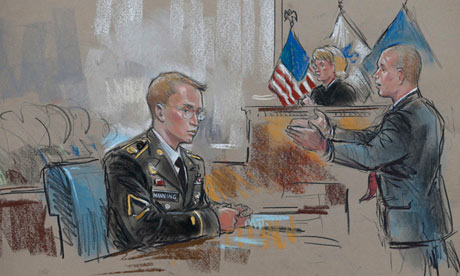Bradley Manning built close ties to Julian Assange, prosecutors claim
Government lawyers use first day of trial to claim records show 'familiarity between Manning and Assange' over WikiLeaks dump

Bradley Manning trial: the accusation was hotly disputed by Manning's defence lawyer, David Coombs. Photograph: Reuters
The US government used the first day of the Bradley Manning trial to allege that the soldier had a much closer relationship with Julian Assange, the founder of WikiLeaks, than has previously been claimed.
Prosecution lawyers peppered the government's opening statement at the trial with references to Assange, suggesting that he built up close ties to the army private over a six-month period in 2009 and 2010.
The government alleged – sometimes directly, on others through insinuation – that Assange guided Manning as to which classified documents to leak, advised him on how to avoid detection and even involved the soldier in the WikiLeaks editing process.
Manning has already admitted to leaking a large cache of diplomatic secrets to WikiLeaks, including a video of a July 2007 helicopter attack in Baghdad in which civilians, including two Reuters journalists, were killed; war logs from Afghanistan and Iraq, and 250,000 diplomatic cables from US embassies around the world.
Captain Joe Morrow, presenting the government's opening statement, cited extracts of a web chat between the soldier and an individual that the prosecution claims was the WikiLeaks founder. The chats showed, he alleged, that there was a "familiarity between Manning and Julian Assange".
As early as 29 November 2009, just two weeks after he began working as an intelligence analyst in Iraq, Manning obtained the personal telephone number of Assange in his base in Iceland. Between then and his arrest in May 2009, Manning searched for the term "WikiLeaks" more than 100 times on the secure intelligence databases that he was authorised to use at Forward Operating Base Hammer outside Baghdad.
Morrow alleged that examinations of Manning's computers revealed an email exchange between him and WikiLeaks in which the soldier took part directly in the editing process of a video showing a US Apache helicopter attack on a group of civilians in Baghdad in 2007 in which two Reuters journalists were killed. The video was released by WikiLeaks with sensational worldwide impact in April 2010 under the title Collateral Murder.
The prosecution case that Assange and Manning were actively acting together has widespread ramifications, not just for the trial of Manning, who faces 21 counts relating to the leaks that carry a possible life in military custody. The claim also has potentially serious implications for Assange himself, who has been, and may still remain, the subject of a grand jury investigation in Virginia exploring the possibility of a federal criminal prosecution against him.
Assange, who remains holed up in the Ecuadorean embassy in London attempting to fight extradition to Sweden on sexual assault allegations, has long insisted that the US government is preparing to hold him responsible for the WikiLeaks disclosures of hundreds of thousands of state secrets including embassy cables, war logs and videos. Assange believes the US government will press for his extradition to face charges should he be forced to go to Sweden.
In legal argument before the trial began, the US government alleged that WikiLeaks guided the selection of documents leaked by Manning through its 2009 "most wanted list", which provided the soldier with a "menu" from which he would do his searches. Prosecutors claimed that Manning sought intelligence using precisely the same file names as contained on the WikiLeaks itinerary.
The accusation was hotly disputed by Manning's defence lawyer, David Coombs. "There is no evidence to support that Manning took direction from WikiLeaks or that he used this list as a guide to what he would give to WikiLeaks. Mr Manning was not taking his direction from WikiLeaks," Coombs told the court.
The prosecution's allegations of a direct interplay between the soldier and Assange extended to the assessment reports on detainees in Guantánamo Bay, which were among the WikiLeaks disclosures. Morrow said that Manning initially downloaded about 400 detainee assessments, but then he went back to the secure intelligence database on which they were stored and downloaded a total of more than 750.
Morrow added that in the chat logs with Assange, Manning had asked the WikiLeaks founder about how "valuable" the assessments were. In other communications, Assange was alleged to have advised the soldier on "finding ways to browse Siprnet [a secure database] anonymously".
On 10 May 2010 WikiLeaks put out a tweet asking for as "many .mil email addresses as possible … please submit". The next day, the government alleged, Manning downloaded form a classified database the email addresses and names, ranks and positions of more than 74,000 service members on the Iraq global address list.
No comments:
Post a Comment